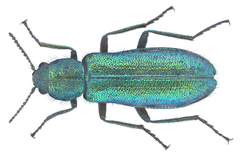| Psilothrix viridicoerulea | |
|---|---|

| |
| Scientific classification | |
| Kingdom: | |
| Phylum: | |
| Subphylum: | |
| Class: | |
| Order: | |
| Family: | |
| Subfamily: | |
| Genus: | |
| Species: | P. viridicoerulea
|
| Binomial name | |
| Psilothrix viridicoerulea (Geoffroy, 1785)
| |
| Synonyms | |
| |
Psilothrix viridicoerulea is a species of soft-winged flower beetle belonging to the family Melyridae, subfamily Dasytinae. [1]
Distribution
This beetle is mainly present in most of Europe (Belgium, Netherlands, Denmark, Italy, Spain, Portugal, Greece, Croatia, France, Germany, Ireland, Latvia, Malta, North Macedonia, Slovenia, Sweden and Switzerland) and in the Near East. [2] There are also additional localized populations in England, mostly on the southern coastline.
Habitat
They are quite common in summer on meadows, pastures, and grasslands, to be seen on a variety of flowers.
Description
The adults grow up to 4.8–6.6 millimetres (0.19–0.26 in) long. [3] The colour of this beautiful insect is brilliant metallic bluish-green. Body is rather long and narrow. Head is slightly longer than wide, with a flat face, large, round eyes and short, green-metallic, hairy antennae, composed by eleven short inwards protruding articles. Pronotum and elytra are thickly, deeply and strongly punctuated and covered of black erect hairs. Elitra are very elongated, square at the base. Legs are long and slender, greenish and hairy. [3] Pygidium (last male tergite) shows a deep but small V-shaped notch.[4] This species is rather similar to Psilothrix aureola. [4]
Biology
The larvae initially feed on dead insects, then become phytophagous. They bore longitudinal galleries in the stems of some annual weeds (Ferula, Magydaris, Carlina, Cirsium, etc.). Metamorphosis takes place in late winter within. The adults leave the pupal chamber in following spring. This species is often associated with graminaceous grasses.[4]
Gallery
-
Mating couple
-
Feeding on pollen of Aizoanthemum hispanicum
-
Mounted specimen
Bibliography
- La faune de la France illustrée - Rémy Perrier - Tome VI Coléoptères 2nd part
References
- ^ Biolib
- ^ Fauna europaea
- ^ a b La valle del Metauro (in Italian)
- ^ a b c G. Liberti The Dasytidae (Coleoptera) of Sardinia
External links
- Listado entomologico
- Entomolane (in French)



